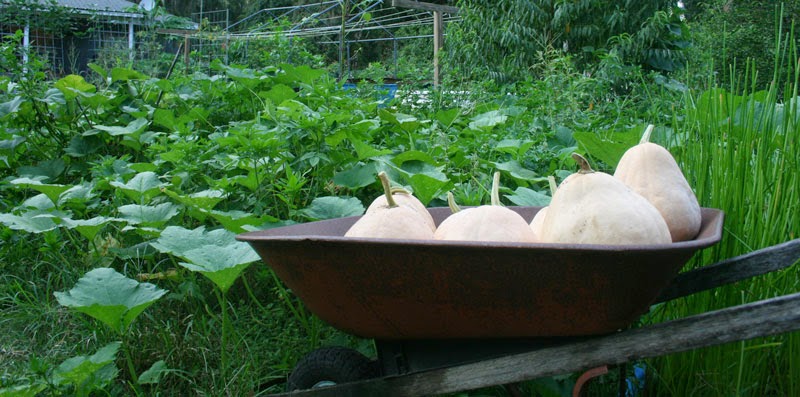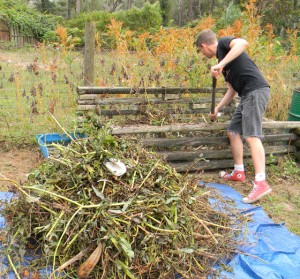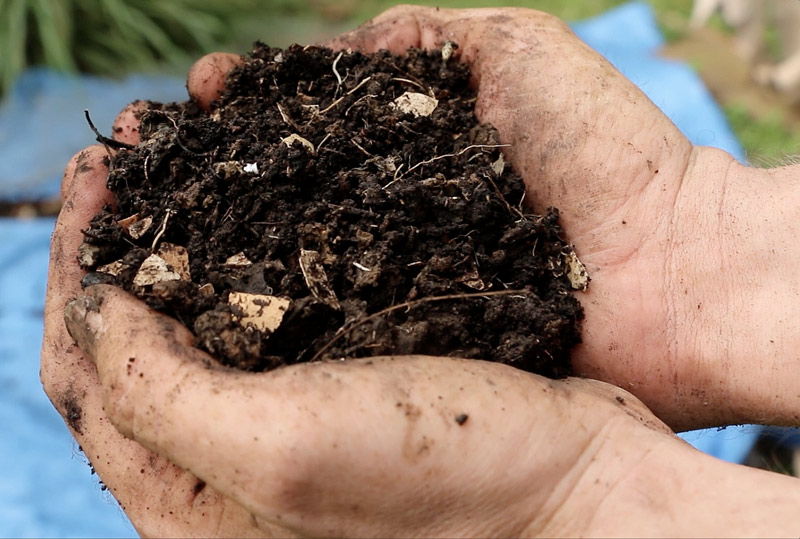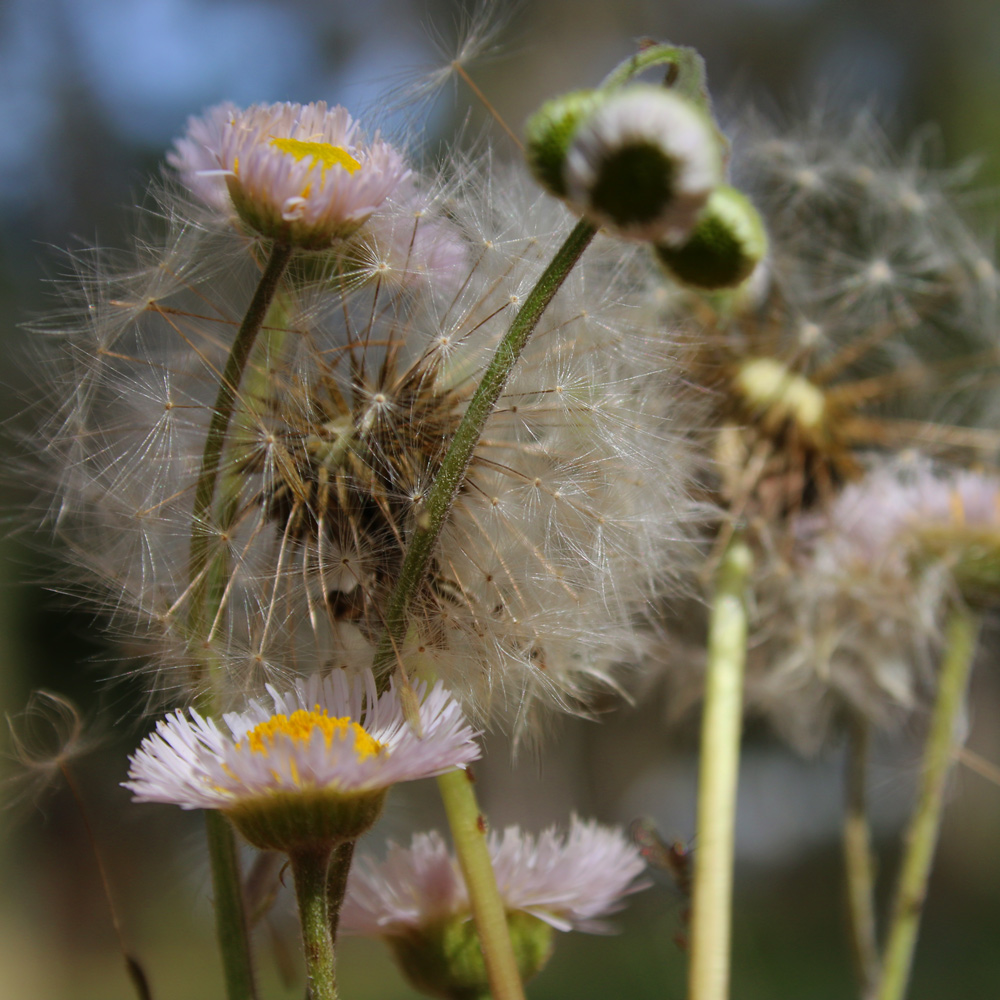Does composting destroy weed seeds?
We are regularly assured by composting experts that hot composting destroys seeds… yet I have some pumpkins that beg to differ:

Those pumpkins grew as volunteers from one of my compost piles a few years ago. Granted, it wasn’t a regularly turned pile, meaning that they probably missed the hottest part of the compost… but how many of you have turned your compost regularly and still had little tomatoes or weeds pop up in it?
My bet is ALL of you.
Here’s an example of “hot composting kills weed seeds” advice from Aggie Horticulture:
“The composting process also naturally kills weed seeds. Properly managed, a compost pile should easily reach 140°F, which breaks down all organic matter, including weed seeds.”
They recognize the difficulty, though, as the next line reads:
“The key word is properly.”
My bet is that few gardeners reach that lofty, “proper” goal.
Why Our Backyard Compost Doesn’t Kill Weed Seeds

A typical backyard compost heap isn’t insulated or turned often enough to maintain heat and rotate all the viable seeds in the compost through the hot center of the pile.
Yes, the heat generated by thermophilic bacteria in a hot compost pile is high enough to destroy seeds, but getting every bit of your compostable materials hot enough to kill the seeds takes very good compost management.
My old pile didn’t do it. It was built from reclaimed landscape logs with too many gaps to get everything hot. Plus, turning it was a pain.
I imagine if you owned a cement truck and packed the barrel of it with a proper mix of carboniferous and nitrogenous materials, then rotated it every day or so, and perhaps insulated the inside with foam, you could get that compost to heat up perfectly.
I’m joking. A bit.
My composting methods have gone from complicated to simple over the years as I’ve realized creating perfect compost doesn’t really matter.
Nature doesn’t create perfectly sifted, totally rotten-down brown humus. No, she throws logs and leaves on the ground. There’s always some finished material and some fresh material, some fungi eating at this and some insect boring away at that.
But let me back up. What prompted today’s post?
This Viewer Asked a Question
There was a comment that prompted today’s great big post on weed seeds in compost. Four words that led to 1145 words:

Martha asked this question on this anaerobic compost tea video I posted back in the summer:
My answer was:
“Good question. I try to avoid throwing plants with mature seeds into the tea. They never seem to get completely killed in hot compost piles, either, though, even though we hear all the time that “hot composting kills weed seeds!” It’s probably true for the ones in the middle of the pile, but I’m always getting volunteer tomatoes, wheat from straw, weeds, and pumpkins popping up even from hot piles. My guess is that this tea method will rot down most of the seeds if it sits long enough but not all of them.”
It takes a lot of faith in your compost-fu to deliberately throw in weedy materials, no matter how you’re composting.
If you have spiny pigweed going to seed in your food forest, do you really think you’ll be able to throw that in your compost bin and then use the resulting compost in your spring gardens?
Do you want to take that risk?

But I Compost the Right Way!
That’s fine – I appreciate the thermometer and sifter brigade.
To those about to compost, I salute you!
I am totally sure that I could destroy weed seeds by hot composting if I thought it out properly. My interest, however, is more in gardening than in the processes that lead up to it. Making “perfect” looking compost isn’t as important to me as growing corn, pumpkins, beans, yams and fruit trees. I also don’t like spending money to make perfect systems.
If you enjoy it, that’s fantastic. I love the smell, look and taste (well, maybe not taste) of finished compost. I made some nice-looking stuff myself this year and just sifted it the other day:

I made that compost with almost no work, though. No thermometers, no turning, no measuring ratios of carbon/nitrogen to get that 25/1 mix. No, I just threw it all on the ground in one of my garden beds.
And – oh YES – LOTS of seeds came up in it! Enough to start my new fruit tree nursery.
I view this as a feature, not a bug. Sometimes I just let compost piles turn into garden beds since there are so many volunteer edibles coming up.
But What About Killing Weed Seeds???
Right – that’s what you all want to know, right? How CAN you compost those pesky weedy plants?

My favorite method is to keep them out of the compost piles and gardens altogether.
In my former food forest I would just chop down weeds and throw them on the ground around my fruit trees and other shrubs. If they self-seeded and came back, I’d chop them down again.
Unlike delicate annual garden plants such as lettuce and cabbage, trees and shrubs don’t need to be perfectly weeded in order to produce. I just knocked down the weeds again and again, and every time I did, guess what?
Those fallen weeds rotted into humus.
Nature does this all the time. The winter freezes come once a year and toast all the weeds, letting them fall down and rot into the soil, improving it. The Bible instructed the children of Israel to let their land go completely fallow one year out of seven. Weeds regenerate the soil, as I’ve written before.
If you want to use weeds to feed your gardens, you’ll have much better luck in a no-till system where you throw a pile of seedy weeds on the ground, then cover them up with mulch… and then DON’T TILL!
If you till, you’ll bring those seeds up to the light and warmth and they’ll go crazy in your eggplants. Beneath a layer of mulch, however, they’ll eventually rot away safely.
 That’s my two cents on composting destroying weed seeds. Yes, it can – but most of us aren’t doing it “properly,” so don’t trust too much in the magic of compost to pile-drive your pesky pigweed problems.
That’s my two cents on composting destroying weed seeds. Yes, it can – but most of us aren’t doing it “properly,” so don’t trust too much in the magic of compost to pile-drive your pesky pigweed problems.
Personally, I prefer cold composting anyhow as I believe it keeps more of the good stuff in the pile instead of steaming away into the air. Nature almost always cold composts, and while that process takes longer I think it’s a simpler and gentler method.
Then again, I may just be lazy.
You decide.
And go get my book Compost Everything if you really want to transform your thinking on the wonders of composting. It’s even available as an audiobook, read by me.
And it’s funny.


15 comments
I’m also on the cold compost bandwagon. I was reading about soil solarization today using plastic mulch after I saw Huw doing it, and learned it kills at least half the microbes, and that was only heating the soil above 45C. Don’t tell Huw.
My regular cold compost loves to grow pumpkins, corn and weed seeds, however what I have found interesting is my experimental vermicompost pots.
I made a flow-through vermicompost bin out of large plant pots stacked on top of one another with the base of the top pot fitting into the top of the bottom pot. I then cut the bottom out of the top pot and added some holes or slits with a knife for air to both. Then I fill from the top with compost, worms from the garden and kitchen scraps to get it started. I raise the pots to collect the leachate and use a pot tray as a lid. I keep adding scraps, and it keeps wanting more, eventually worms keep falling out to make a worm soup leachate. When it’s eventually full, I remove from the pot at the bottom and because the pots have tapered walls they hold the contents and worms in place. I throw all my weed seeds in there and I haven’t seen any make it through yet.
The only problem is that I get this thick mud-like vermicompost out of it, but when I add it to the top of pot plants and beds and then cover with mulch they love it. The stuff is the bomb. The worm soup leachate goes on all my seedlings and makes them go boom too. I noticed that when I put my used guinea pig oaten hay on top the mycelium go nuts and it’s covered in threads in no time.
The other day I saw a permie throw his biochar in a cement mixer with rocks to micronise it, as this increases the surface area and CEC further.
I’m thinking of adding some of that to it next, to see if that makes it less like mud.
I like that cement mixer idea.
Also, I feel you on soil solarization – yet at the same time, a lot of that microbiology can regenerate very quickly. I’m on the fence.
I used to be on the fence too. :) The solarization studies I read used gene sequencing to measure the diversity. And while I agree that microbiology can regenerate quickly, diversity may not. One study mentioned that after only 4 weeks ofsolarization, that native arbuscular mycorrhizae took 6 weeks to even begin recolonizing plants and never reached the same level as the control, likely because of competition. Most of the solarization studies I came across were about killing plant pathogens for industry and while they achieved that they also often hurt yield.
Makes sense to me. Yikes.
That’s like something I did but on mine I cut the bottom out of the first pot and stuck it in the ground filled it with shredded leaves and food scraps and the second pot fit inside of the bottom pot which I filled the same way and the top pot also feeding materials as the last two but that had a cover to keep out the critters. It worked out so well that I will do it again this spring!
I hate overly complex systems, because I don’t have the time to manage them. I dig a big hole and throw everything in and cap it with dirt. That’s it.
Last fall I had a lot of sticks, raspberry brambles, rotten wood, so I threw all that in and lit it on fire. After it had burned down a bit I buried it under fall leaves and a layer of dirt. Voila! Biochar in a deep layer, about 3-4 feet deep. On top of that goes alternating layers of leaves and dirt, leaves and dirt, leaves and dirt, along with whatever kitchen waste we produce, and shredded paper.
I live in the north, and burn wood all winter in the fireplace. All the ash and char left over gets mixed with the kitchen waste and shredded paper and dumped into the pit. In the spring when the soil thaws, the pit will get filled in and planted over.
I have been working on this plot for 3 years now and finally getting some good soil out of the heavy red clay subsoil that the developer left behind after scraping the topsoil off and building the house.
Is deep digging 3-4 feet deep necessary? No, but it is kind of fun, and even the deepest-rooted plants have plenty of space to spread out roots into.
Simple is good.
That’s a great way to do it. You’ll build the soil long term.
Australian subsoil manuring studies I’ve seen recommend using materials with a C:N of 25:1 to break up our heavy clays. Fresh leaves are pretty close to that, dead leaves are up near 60:1 I think and may take a lot longer. 25:1 is basically the same C:N as the microbes themselves that do the work, and also why they recommend the moisture be maintained in the subsoil to keep the microbes active, otherwise it doesn’t happen, and we tend to have droughts here.
For most natural soil profiles I’ve seen, below 2 feet they become anaerobic and this is reflected in soil organic carbon in the soil profile. So if you want to sequester carbon for a millennium I believe you need to go deeper than this, that’s the only reason I can think of to dig 4 foot, unless you have an excavator. :) One of the Terra preta soils I’ve seen that also contains a lot of deep ceramic pottery shards indicating it was a trash pile, appears to be 6-8 feet!
That is a ton of digging – no way I could pull that off in the soil here without a jackhammer. Could have done it in Florida sand, though.
>Yes, the heat generated by thermophilic bacteria in a hot compost pile is high enough to destroy seeds
Not true at all. Some seeds can withstand the heat of a forest fire (much hotter than a compost pile), and even need it to trigger release or sprouting!
To research this, investigate: fire ecology, fire regime, serotiny
Good point to bring up. Though there is an extended heat in composting, rather than a fast, hot fire – that’s perhaps why experts always claim thermophilic compost destroys weed seeds. Perhaps it’s also a category, as many of the seeds directly deployed after a forest fire are tree seeds; pines in particular. “Weed seeds” may get killed, whereas they may not. That said, the mechanisms protecting those seeds might not survive in that active pile for weeks. Worth researching for sure.
Thank you for this article and video. In gardening with friends we have differing opinions on many garden topics. I prefer cool/slow-composting and I compost weeds. I chop and drop a lot of weeds, add piles of the not-seedy ones to the compost area (where the chickens pick through them), and place seedy ones in a big black bucket to ferment for weeks/months/whenever I get around to dumping it out. Then I dump it on a new compost pile to energize the pile. I’m glad I’m not the only one who sees value in garden weeds.
Very good, Miranda – I like that idea.
So what I hear is 140F will kill seeds. Don’t believe it.
For all of you people who can tomatoes and blanch the tomatoes for awhile to get the skin off this is for you.
Maybe all the seeds inside the tomato don’t reach 212F but I’m sure they reach 140F.
When I’m done with the skin, core and seeds I throw them on top of the garden.
A week later I have all the wild tomatoes that I could handle. I believe every seed sprouts. It actually looks like grass growing in the patch.
Heh.
Comments are closed.